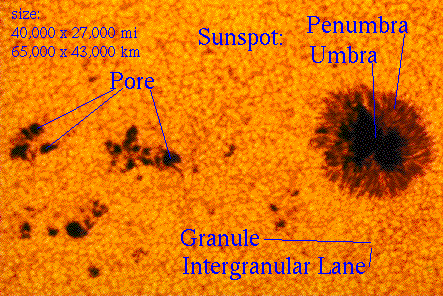
Sunspots are irregularly shaped dark areas on the face of the sun. They look dark because they are cooler than the surrounding material. The strong local magnetic fields push away some of the hot ionized material rising from lower in the photosphere. A sunspot is not uniformly dark. Its center, called the umbra, is darkest and is surrounded by a lighter penumbra. If you think of them as blemishes on the face of the sun, just remember that one such blemish may easily be the size of the earth or larger.
Sunspots may persist for months, and they may appear singly, although, usually, they are found in pairs or groups. Such typical groupings are related to the magnetic nature of the sunspots. Every pair of spots has a leader and a follower (with respect to the direction of the sun’s rotation), and the leader’s magnetic polarity is always the opposite of the follower. That is, if the leader is a north magnetic pole, the follower will be a south magnetic pole.
Sunspots are never seen exactly at the equator or near the solar poles, and leaders and followers in one hemisphere of the sun are almost always opposite in polarity from those across the equator. That is, if all the leaders in the northern hemisphere are south magnetic poles, all the leaders in the southern hemisphere will be north magnetic poles.
We have said that sunspots are thought to be associated with strong local magnetic fields. But why are the fields strong in certain regions of the photosphere? A meteorologist from Norway, Vilhelm Bjerknes (1862–1951) concluded in 1926 that sunspots are the erupting ends of magnetic field lines, which are distorted by the sun’s differential rotation. That is, like the gas giant jovian worlds, the sun does not rotate as a single, solid unit, but differentially, at different speeds for different latitudes. The sun spins fastest at its equator—the result being that the solar magnetic field becomes distorted. The field lines are most distorted at the equator, so that the north-south magnetic field is turned to an east-west orientation. In places where the field is sufficiently distorted, twisted like a knot, the field becomes locally very strong, powerful enough to escape the sun’s gravitational pull. Where this happens, field lines “pop” out of the photosphere, looping through the lower solar atmosphere and forming a sunspot pair at the two places where the field lines pass into the solar interior.

No comments:
Post a Comment